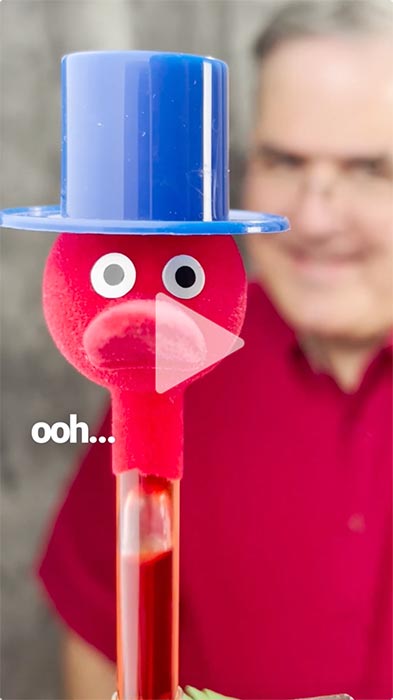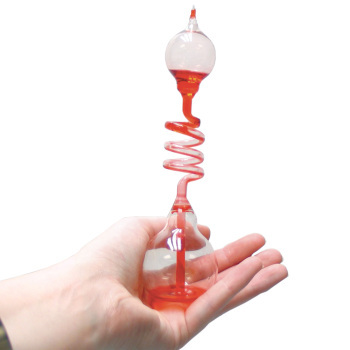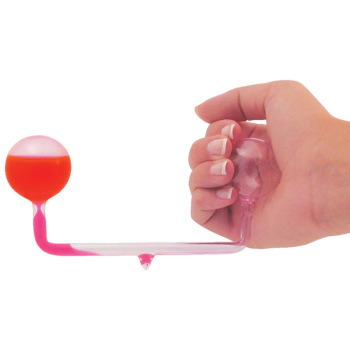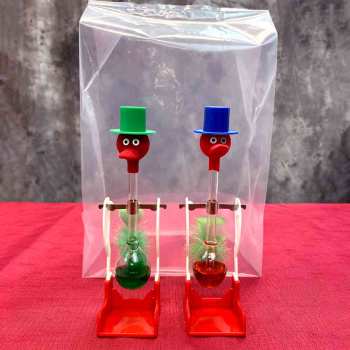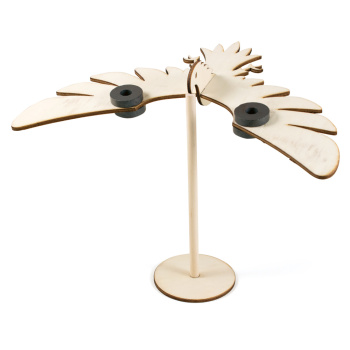Description
Simply moisten the bird's head with water, place it next to a full glass of water and watch as the bird periodically dunks its head into the glass for a "drink". It continues for hours. Great centerpiece for class discussion or laboratory exploration. How does it work? Is it really perpetual motion? Does it work better with hot or cold water? Does it work in an enclosed space, such as an inverted aquarium? Each bird comes complete with an explanation for teachers and suggested experiments. We have had many requests for this product over the years. Whether you are interested in the science behind this fifty-year-old scientific toy or have just fallen in love with its adorable face, it makes a great addition to the classroom or a great gift! (6" tall.) Colors may vary. Read more on our Blog - First Graders and the Drinking Bird: A Love Story
Read more on our Blog - First Graders and the Drinking Bird: A Love Story
 Read more on our Blog - Why Is a Drinking Bird Like a Dog on a Hot Day?
Read more on our Blog - Why Is a Drinking Bird Like a Dog on a Hot Day?
 Read more on our Blog - The Flock Clock
Read more on our Blog - The Flock Clock
 Read more on our Blog - The Amazing Drinking Bird
Read more on our Blog - The Amazing Drinking Bird

Lesson Ideas
When the felt on the head of the sealed glass bird is wet with water, the bird pivots back and forth into a glass of water. It gives the appearance of drinking!
Instructions:
Wet the head of the Drinking Bird, and place a full glass of water near it so that when the head tips forward, only the beak comes in contact with the water. Most Drinking Birds work without adjustment! Sometimes a small adjustment to the pivot point of the bird is needed. Carefully move the metal clip up or down the glass tube, (ca. a millimeter), until the Drinking Bird just balances in a vertical position.
Explanation:
Step #1
Water requires heat to evaporate. In this demonstration, water from the wet felt on the outside of the head evaporates, causing the vapor inside the head of the bird to cool. This reduces the pressure of the vapor at the top, allowing the higher pressure in the lower bulb to push up the column of liquid. The pressure of the vapor in the top bulb decreases for two reasons:
- As the vapor cools, the vapor contracts. Notice the top volume of gas decreasing, and
- As the rising liquid near the top cools, less liquid evaporates into the head and more vapor returns to the liquid state. Since this demonstration only works with a sealed liquid that has a high vapor pressure, this is a major factor.
Step #2
As the head cools further and more liquid inside the bird rises, the center of gravity of the bird rises, causing the bird to become unstable and tip forward.
Step #3
Eventually, the beak of the bird tips forward enough to rewet its head. When this happens, the bottom end of the glass tube in the lower bulb is above the remaining liquid. Vapor from the bottom travels to the top until the pressure is equalized. At the same time, liquid in the column flows to the bottom. As the center of gravity of the bird is lowered, the bird tips vertical and the cycle starts over.
Suggested Classroom Activities:
I) Classroom Discussion
Q. Is this an example of perpetual motion?
A. No. The cycle repeats itself only as long as the water evaporates from the head
Q. What is needed in order for the Drinking Bird to work?
A. A difference in temperature between the head and body.
II) Student Challenges
- Observe the operation of the Drinking Bird and explain how it works.
- Discover a way to make the Drinking Bird cycle faster.
- Predict what will happen if a fan blows air toward the Drinking Bird. Does it make a difference which direction the air blows?
- Predict the result of using warmer or cooler water in the glass.
- How long will the bird cycle without needing a refill of the water in the open container? Can you find a way of causing the bird to cycle longer?
- Is there a difference in the cycle rate on a humid day vs. a dry day? Can the bird be used to determine the relative humidity in the air?
- Predict the result of placing a small inverted aquarium over the bird. Does this cause the bird to cycle more or less? (Note: as soon as the water in this closed system reaches its vapor pressure, water from the felt can no longer evaporate and the bird stops.)
- Can you attach a thread to the bird so that it does useful work, e.g. lifting a small paper clip?
Reviews




 Jul 18, 2023
Jul 18, 2023
Was this review helpful?




 May 9, 2019
May 9, 2019
Was this review helpful?




 Sep 25, 2017
Sep 25, 2017
Was this review helpful?




 May 15, 2017
May 15, 2017
Was this review helpful?




 Feb 5, 2015
Feb 5, 2015
Was this review helpful?




 Apr 2, 2014
Apr 2, 2014
Was this review helpful?




 Dec 19, 2013
Dec 19, 2013
Was this review helpful?




 Aug 2, 2013
Aug 2, 2013
Was this review helpful?




 Apr 4, 2013
Apr 4, 2013
Was this review helpful?




 Jan 23, 2013
Jan 23, 2013
Was this review helpful?




 Jan 18, 2013
Jan 18, 2013
Was this review helpful?




 Sep 17, 2012
Sep 17, 2012
Was this review helpful?




 May 30, 2012
May 30, 2012
Was this review helpful?




 May 29, 2012
May 29, 2012
Was this review helpful?




 May 29, 2012
May 29, 2012
Was this review helpful?




 May 22, 2012
May 22, 2012
Was this review helpful?




 May 22, 2012
May 22, 2012
Was this review helpful?




 May 22, 2012
May 22, 2012
Was this review helpful?




 May 22, 2012
May 22, 2012
Was this review helpful?




 May 19, 2012
May 19, 2012
Was this review helpful?




 May 18, 2012
May 18, 2012
Was this review helpful?




 May 18, 2012
May 18, 2012
Was this review helpful?




 May 17, 2012
May 17, 2012
Was this review helpful?




 May 17, 2012
May 17, 2012
Was this review helpful?




 May 17, 2012
May 17, 2012
Was this review helpful?




 May 16, 2012
May 16, 2012
Was this review helpful?




 May 16, 2012
May 16, 2012
Was this review helpful?




 May 16, 2012
May 16, 2012
Was this review helpful?




 May 16, 2012
May 16, 2012
Was this review helpful?




 May 16, 2012
May 16, 2012
Was this review helpful?




 May 16, 2012
May 16, 2012
Was this review helpful?




 May 16, 2012
May 16, 2012
Was this review helpful?
NGSS
This product will support your students' understanding of the Next Generation Science Standards (NGSS)*, as shown in the table below.| Elementary | Middle School | High School | ||
| K-ESS2-1 Students can use the Drinking Bird Demonstration to use and share observations of local weather conditions and describe patterns over time. 3-PS2-2Students can use the Drinking Bird Demonstration to make observations and/or measurements of an object's motion to provide evidence that a pattern can be used to predict future motion. 4-PS3-2Students can use the Drinking Bird Demonstration to make observations to provide evidence that energy can be transferred from place to place by heat. 4-PS3-4Students can use the Drinking Bird Demonstration to design, test, and refine a device that converts energy from one form to another. | MS-PS2-2 Students can use the Drinking Bird Demonstration in the plan of an investigation to provide evidence that the change in an object's motion depends on the sum of the forces on the object and the mass of the object. MS-PS2-4Students can use the Drinking Bird Demonstration in an investigation to construct and present arguments using evidence to support the claim that gravitational interactions are attractive and depend on the masses of interacting objects. MS-PS3-2Students can use the Drinking Bird Demonstration to develop a model to describe that when the arrangement of objects interacting changes, different amounts of potential energy are stored in the system. MS-PS3-3Students can use the Drinking Bird Demonstration to test what either minimizes or maximizes thermal energy transfer. | HS-PS2-4 Students can use the Drinking Bird Demonstration as an introduction to an investigation to use mathematical representations of Newton's Law of Gravitation to predict the gravitational forces between objects. HS-PS3-3Students can use the Drinking Bird Demonstration to refine a device that works with given constraints to convert one form of energy into another form of energy. HS-PS3-4Students can use the Drinking Bird Demonstration to conduct an investigation to provide evidence that the transfer of thermal energy when two components of different temperature are combined within a closed system results in a more uniform energy distribution among the components in the system. |
This amazing 50+-year-old science toy can be linked to physical science, earth science, chemistry and more. Effective for students of all ages. It is important before starting any of the investigations; make sure the bird is at equilibrium. A slight adjustment at the fulcrum or metal clip on the neck up or down is all that is needed until Drinking Bird just balances in a vertical position.
K-ESS2-1The speed of the bird's dipping cycle changes due to the humidity in the air. If the students watch and collect data; overtime in different weather conditions they will see a correlation. Students can use the Drinking Bird Demonstration to use and share observations of local weather conditions and describe patterns over time.
3-PS2-2Students can use the Drinking Bird Demonstration to make observations and investigate motion. Have the students change the temperature of water and make predictions about the speed of the dipping cycle.
4-PS3-2MS-PS3-3
HS-PS3-3
HS-PS3-4
Water requires heat to evaporate. In this Drinking Bird Demonstration, water from the wet felt on the outside of the head evaporates, as the vapor in the head cools, the vapor contracts. This causes higher pressure in the lower bulb, allowing liquid to raise up the neck, the center of gravity rises, resulting in the bird to become unstable and tip forward. When the head gets wet, the cycle repeats itself.
MS-PS2-4HS-PS2-4
Students can use the Drinking Bird Demonstration in an investigation to understand Center of Mass as pressure inside bird changes, so does the fluid moving up the tube.
* NGSS is a registered trademark of Achieve. Neither Achieve nor the lead states and partners that developed the Next Generation Science Standards were involved in the production of, and do not endorse, this product.
You May Also Like
-
$5.95
-
$11.95
-
$5.95

